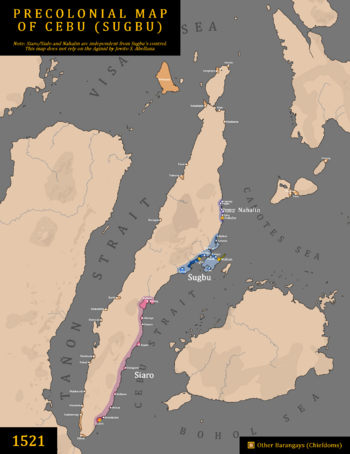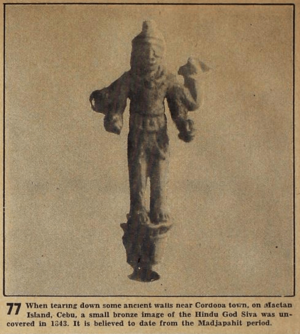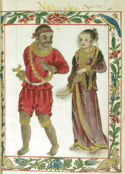Cebu (historical polity) facts for kids
The Rajahnate of Cebu, also known as Sugbu, was an old kingdom on the island of Cebu in the Philippines. It was a powerful state influenced by Hinduism and had connections with the Chola dynasty from southern India. This kingdom existed before the Spanish arrived in the 1500s. Ancient Chinese records called it Sokbu.
Quick facts for kids
Rajahnate of Cebu
Sugbu
|
|||||||||
|---|---|---|---|---|---|---|---|---|---|
| c.1400–1565 | |||||||||

Map of the Rajanate of Cebu in 1521, with Sugbu under Rajah Humabon colored as dark blue, and its subordinate barangays as lighter blue. Mactan under Si Lapulapu is colored yellow green.
|
|||||||||
| Capital | Singhapala (Modern Mabolo district in Cebu City) | ||||||||
| Common languages | Old Cebuano, Old Malay, Middle Tamil | ||||||||
| Religion | Syncretic form of Hinduism, Buddhism and Animism (see also Polytheism) Roman Catholicism (since 1521) |
||||||||
| Rajah | |||||||||
|
• 1521
|
Rajah Humabon | ||||||||
|
• 1521–1565
|
Rajah Tupas (last) | ||||||||
| History | |||||||||
|
• Established
|
c.1400 | ||||||||
|
• Disestablished
|
4 June 1565 | ||||||||
| Currency | Barter | ||||||||
|
|||||||||
| Today part of | Philippines | ||||||||
| Pre-colonial history of the Philippines |
| Barangay government |
| Ruling class (Maginoo, Tumao): Apo, Datu, Lakan, Panglima, Rajah, Sultan, Thimuay |
| Middle class: Timawa, Maharlika |
| Serfs, commoners and slaves (Alipin): Aliping namamahay, Alipin sa gigilid, Bulisik, Bulislis, Horohan, Uripon |
| States in Luzon |
| Caboloan |
| Cainta |
| Ibalon |
| Ma-i |
| Rajahnate of Maynila |
| Namayan |
| Tondo |
| States in the Visayas |
| Kedatuan of Madja-as |
| Kedatuan of Dapitan |
| Rajahnate of Cebu |
| States in Mindanao |
| Rajahnate of Butuan |
| Rajahnate of Sanmalan |
| Sultanate of Sulu |
| Sultanate of Maguindanao |
| Sultanates of Lanao |
| Key figures |
|
| The book of Maragtas |
| Religion in pre-colonial Philippines |
| History of the Philippines |
| Portal: Philippines |
Contents
History of the Rajahnate of Cebu
How the Kingdom Started

According to old stories from the Visayas, a prince named Sri Lumay founded the Rajahnate of Cebu. He was part Tamil and part Malay. He came from the Chola dynasty in southern India. Sri Lumay was sent to set up a trading post. But he decided to create his own independent kingdom instead.
Sri Lumay had several sons. One son, Sri Alho, ruled the area of Sialo. Another son, Sri Ukob, ruled Nahalin in the north. Sri Ukob died fighting against Moro pirates from Mindanao. These pirates were called magalos, meaning "destroyers of peace."
Sri Lumay was known for his strong defense against these raiders. He used a tactic called "scorched earth." This meant burning everything so invaders couldn't use it. This gave the town its name, Kang Sri Lumayng Sugbu, which means "that of Sri Lumay's great fire." Later, it was shortened to Sugbu, meaning "scorched earth."
The capital city of the kingdom was Singhapala. This name means "Lion City" in Tamil-Sanskrit. It's similar to the name of the modern city-state of Singapore.
Rulers of Cebu
Sri Bantug's Rule
After Sri Lumay, his youngest son, Sri Bantug, became the ruler. He ruled from Singhapala, which is now the Mabolo area of Cebu City. Sri Bantug got sick and died.
Sri Bantug had a brother named Sri Parang. Sri Parang was supposed to rule next, but he was crippled and couldn't lead the kingdom. So, he gave the throne to Sri Bantug's son, Sri Humabon.
Rajah Humabon's Time
During Rajah Humabon's rule, Cebu became a very important place for trading. People traded farm products there. From Japan, people brought perfume and glass items. From India and Burma, traders brought ivory, leather, jewels, and sugar.
The harbors of Sugbu became known as sinibuayang hingpit, which means "the place for trading." This was shortened to sibu or sibo, meaning "to trade." This is where the modern name "Cebú" comes from.
It was also during Rajah Humabon's time that Lapulapu arrived from Borneo. Rajah Humabon gave Lapulapu the region of Mandawili (now Mandaue) and the island of Opong (now Mactan).
First Contact with Europeans
The first Europeans arrived in Cebu during Rajah Humabon's rule. This led to the death of the explorer Ferdinand Magellan.
A merchant warned Rajah Humabon about Magellan's group. He said, "Have good care, O king, what you do, for these men are those who have conquered Calicut, Malacca, and all India the Greater. If you give them good reception and treat them well, it will be well for you, but if you treat them ill, so much the worse it will be for you." This warning was in the Old Malay language.
Cebu's Connections with Other Kingdoms
The Rajahnate of Cebu was recognized by other kingdoms in Southeast Asia. When Magellan's ships arrived, his scribe noted that a ship from Siam (Thailand) had just visited Cebu. They had paid tribute to Rajah Humabon, showing respect.
Cebu also had towns and areas that depended on it. Some of these included:
- Cingapola (which was the Spanish way of saying Singhapala)
- Mandani (now Mandaue)
- Lalan
- Lalutan
- Lubucin
The Battle of Mactan
The Battle of Mactan happened on April 27, 1521. It was a fight between Rajah Humabon's forces, which included Ferdinand Magellan and his Spanish soldiers, and the forces of Lapulapu. The battle ended with Ferdinand Magellan being killed.
Rajah Tupas and the Spanish Arrival
After Rajah Humabon, Sri Tupas, also known as Rajah Tupas, became the king of Cebu. He was the young son of Sri Parang.
The Rajahnate of Cebu, which had strong Hindu roots, ended during Rajah Tupas's rule. This happened when the Spanish explorer Miguel López de Legazpi and his forces conquered Cebu in 1565.
Cebu's Relations with Other Kingdoms
The rulers of Cebu were related to the rulers of Butuan. This means they had good connections. For example, Rajah Colambu of Butuan helped Magellan's expedition find its way to Cebu.
However, Cebu was not always at peace with all other kingdoms. The Rajahnate of Maynila, which was a colony of the Brunei Sultanate, had a proud attitude towards the people of Cebu and the Visayas. Rajah Sulayman of Maynila even made fun of the Visayans who helped the Spanish expedition.
Lasting Influence
Even though Spanish culture later became dominant, Indian influences remained in the Cebuano language and culture. You can still find words from Sanskrit and Tamil in the language. Some religious practices also show this influence.
Social Classes in Cebu
In ancient Visayan societies like Cebu, people were divided into different social groups:
- Tumao: These were the royal nobility or the highest class.
- Timawa: This was the warrior class. They were below the tumao but higher than commoners and slaves. They were similar to the Maharlika class among the Tagalog.
- Uripon: These were the commoners, serfs, and slaves. They were the lowest class.
Ancient Artifacts
In 1921, a researcher named Henry Otley Beyer found some old artifacts. These included a simple Buddhist medallion and a copper statue of the Hindu god, Ganesha. They were found in ancient sites in Puerto Princesa, Palawan, and in Mactan, Cebu. The simple style of these items suggests they were made locally. Sadly, these original artifacts were lost during World War II. But we still have black and white photos of them.
Modern Name Ideas
There have been ideas to rename the current Central Visayas region. This region is mostly made up of the Cebuano ethnic group. Some people want to call it the Sugbu region. This was the old name of the area before the Spanish arrived in the 1500s.
See also
- Related to Cebu polity
- Singhapala – the ancient capital of the polity of Cebu.
- Battle of Mactan
- Lapulapu
- Timawa
- Other related
- List of India-related topics in the Philippines
- Hinduism in the Philippines
- History of the Philippines (Before 1521)
- Pintados


